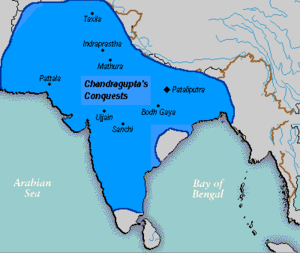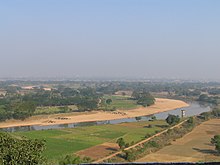| Revision as of 18:07, 24 April 2017 editChackerian (talk | contribs)Extended confirmed users1,840 edits Removed repeated linking and someTag: Visual edit← Previous edit | Revision as of 13:56, 1 May 2017 edit undoInternetArchiveBot (talk | contribs)Bots, Pending changes reviewers5,388,208 edits Rescuing 2 sources and tagging 0 as dead. #IABot (v1.3beta8)Next edit → | ||
| Line 51: | Line 51: | ||
| ==External links== | ==External links== | ||
| * | * | ||
| * | * | ||
| {{-}} | {{-}} | ||
Revision as of 13:56, 1 May 2017
| This article may require copy editing for grammar, style, cohesion, tone, or spelling. You can assist by editing it. (November 2016) (Learn how and when to remove this message) |
| This article needs additional citations for verification. Please help improve this article by adding citations to reliable sources. Unsourced material may be challenged and removed. Find sources: "Kalinga War" – news · newspapers · books · scholar · JSTOR (November 2015) (Learn how and when to remove this message) |
| The neutrality of this article is disputed. Relevant discussion may be found on the talk page. Please do not remove this message until conditions to do so are met. (August 2016) (Learn how and when to remove this message) |
| The Kalinga War | |||||||||
|---|---|---|---|---|---|---|---|---|---|
| |||||||||
| Belligerents | |||||||||
| Maurya Empire | Kalinga | ||||||||
| Commanders and leaders | |||||||||
| Ashoka | Kalingraj | ||||||||
| Strength | |||||||||
| Total 70,700 |
60,000 infantry, | ||||||||
| Casualties and losses | |||||||||
| 10,000 |
200,000+ (Figures by Ashoka himself) (including civilians) | ||||||||
The Kalinga War (c. 262 – c. 261 BCE) was fought in India between the Maurya Empire under Ashoka and the state of Kalinga, an independent feudal kingdom located on the east coast, in the present-day state of Odisha (Orissa) and the north of Andhra Pradesh. The Kalinga War, the only major war Ashoka fought after his accession to the throne, included one of the largest and bloodiest battles in history. Though Kalinga put up a stiff resistance against the brutal strength of the Maurya Empire, they were overwhelmed. The bloodshed of this war is said to have prompted Ashoka to adopt Buddhism. He nevertheless incorporated Kalinga into the Maurya Empire.
Background

The main reasons for invading Kalinga were both political and economic. Kalinga was a glorious and prosperous region consisting of peaceful and artistically skilled people. Also known as the "Utkala", they were the first from the region (present day India) who traveled offshore to the southeast for trade. For that reason, Kalinga had important ports and a powerful navy. They had an open culture and used a uniform civil code.
Since the time of Ashoka's father, King Bindusara, the Maurya Empire based in Magadha, pursued a policy of territorial expansion. Kalinga was under Magadha control during the Nanda rule, but regained independence with the beginning of the rule of the Mauryas. That was considered a great setback for the traditional policy of territorial expansion of the Magadhan emperors, as Kalinga was next to Magadha. It was considered to be a loss of political prestige for the Mauryas, and imperative to reduce Kalinga to complete subjection again. Ashoka set himself to the task as soon as he felt he was securely established on the throne.
Course of the war

As Ramesh Prasad Mohapatra remarks, "No war in the history of India as important either for its intensity or for its results as the Kalinga war of Ashoka. No wars in the annals of the human history has changed the heart of the victor from one of wanton cruelty to that of an exemplary piety as this one. From its fathomless womb the history of the world may find out only a few wars to its credit which may be equal to this war and not a single one that would be greater than this. The political history of mankind is really a history of wars and no war has ended with so successful a mission of the peace for the entire war-torn humanity as the war of Kalinga." The war began in the 8th year of Ashoka's reign, probably in 261 BCE. Ashoka's grandfather Chandragupta had previously attempted to conquer Kalinga, but had been repulsed. After a bloody battle for the throne after Bindusara's death, Ashoka was successful, but the consequences of the savagery changed Ashoka's views on war and led him to pledge to never again wage a war of conquest.
Aftermath
Ashoka had seen the bloodshed with his own eyes and felt that he was the cause of the destruction. The whole area of Kalinga was plundered and destroyed. Some of Ashoka's later edicts state that about 100,000 people died on the Kalinga side and almost equal number of Ashoka's army, though legends among the Odia people (the present day descendants of Kalinga's natives) claim that these figures were highly exaggerated by Ashoka. As per the legends, Kalinga Armies caused twice the amount of destruction they received. Thousands of men and women were deported. After seeing this, Ashoka was filled with sorrow and remorse.
Ashoka's response to the Kalinga War is recorded in the Edicts of Ashoka. The Kalinga War prompted Ashoka, already a non-engaged Buddhist, to devote the rest of his life to Ahimsa (non-violence) and to Dharma-Vijaya (victory through Dharma). Following the conquest of Kalinga, Ashoka ended the military expansion of the empire, and led the empire through more than 40 years of relative peace, harmony, and prosperity.
- "Beloved-of-the-Gods, King Priyadarsi, conquered the Kalingas eight years after his coronation. One hundred and fifty thousand were deported, one hundred thousand were killed and many more died (from other causes). After the Kalingas had been conquered, Beloved-of-the-Gods came to feel a strong inclination towards the Dharma, a love for the Dharma and for instruction in Dharma. Now Beloved-of-the-Gods feels deep remorse for having conquered the Kalingas.
According to oral histories, a woman approached him and said, "Your actions have taken from me my father, husband, and son. Now what will I have left to live for?" Moved by these words, it is said, that he accepted/adopted Buddhism, and vowed to never take life again.
See also
References
- ^ Pliny the Elder (77 CE), Natural History VI, 22.1, quoting Megasthenes (3rd century BCE), Indika, Fragm. LVI.
- Roy, Kaushik. Military Manpower, Armies and Warfare in South Asia. Routledge, 2015. Retrieved 17 August 2015.
{{cite book}}:|website=ignored (help) - Ashoka (r. 268–231 BCE), Edicts of Ashoka, Major Rock Edict 13.
- Radhakumud Mookerji (1988). Chandragupta Maurya and His Times. Motilal Banarsidass Publ. ISBN 81-208-0405-8.
- "Detail History of Odisha".
- Das, Manmatha Nath (1949). Glimpses of Kalinga History. Calcutta: Century Publishers. p. VII; 271. Retrieved 16 May 2016.
- "What were the reasons for the Kalinga war? - Quora". www.quora.com. Retrieved 27 January 2017.
- ^ Ramesh Prasad Mohapatra(1986) Page 10. Military History of Orissa. Cosmo Publications, New Delhi ISBN 81-7020-282-5
- Kalinga (India) formed part of the Nanda Empire but subsequently broke free until it was re-conquered by Ashoka Maurya, c. 260 BCE. (Raychaudhuri & Mukherjee 1996, pp. 204-209, pp. 270–271)
- Ramesh Prasad Mohapatra (1986) Page 12. Military History of Orissa. Cosmo Publications, New Delhi ISBN 81-7020-282-5